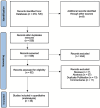Effect of balanced protein-energy supplementation given to pregnant women on birth outcomes: A systematic review and meta-analysis
- PMID: 40305487
- PMCID: PMC12046169
- DOI: 10.1177/17455057251335366
Effect of balanced protein-energy supplementation given to pregnant women on birth outcomes: A systematic review and meta-analysis
Abstract
Background: There is an increased demand for nutrition during pregnancy to improve fetal growth and development. Several dietary interventions have been recommended to pregnant women to meet their maternal needs. Using a larger sample size, we aim to assess the effect of balanced protein-energy supplementation given to pregnant women on birth outcomes.
Objective: To evaluate the effect of balanced protein-energy supplementation given to pregnant women on birth outcomes.
Design: Search included PubMed, Cochrane Central, and Embase from initiation till 20 March 2023 to select relevant studies examining perinatal factors associated with balanced protein-energy supplementation. Mean differences (MD) and risk ratios (RRs) with a 95% confidence interval (CI) were calculated using Review Manager.
Data sources and methods: Randomized controlled trials and observational studies were included. Out of 218,720 studies initially identified, 24 met the inclusion criteria, involving pregnant women who received balanced protein-energy supplementation and reported outcomes related to perinatal death, birthweight, length, or head circumference.
Results: Meta-analysis of pooled studies revealed that balanced protein supplementation had a significant effect on birthweight (g) (MD: 62.67, CI: 27.92-97.43), low birth weight (LBW) (RR: 0.73, CI: 0.57-0.95), birth length (MD: 0.20, CI: 0.10-0.30), and small-for-gestational-age (SGA) babies (RR: 0.74, CI: 0.59-0.93) and had no significant effect on the birth head circumference (MD: 0.05, CI: -0.09 to 0.20), perinatal death (RR: 0.83, CI: 0.50-1.37), and preterm birth (RR: 0.86, CI: 0.68-1.08).
Conclusion: Balanced protein-energy supplementation is an effective intervention for birth length, birth weight, risk of LBW, and SGA births, particularly in women who are undernourished.
Keywords: balanced protein–energy supplementation; birth outcome; birthweight; meta-analysis; pregnant women.
Plain language summary
Looking at the effects of giving pregnant women a balanced combination of protein energy supplements on the results of their pregnancy outcomes, by reviewing and analyzing data from several previous studies.Introduction: During pregnancy, there is a greater need for good nutrition to help the baby grow and develop properly. Different dietary supplements have been recommended for pregnant women to meet their increased nutritional requirements. This study aimed to evaluate the effects of providing a balanced combination of protein and energy supplements to pregnant women on birth outcomes.Methods: The researchers searched various databases to find relevant studies that looked at the relationship between balanced protein–energy supplements during pregnancy and factors like infant birth weight, length, head size, and risk of complications. They evaluated the quality of the studies and used statistical analysis to combine the results.Results: The analysis of the 24 studies, involving over 11,000 pregnant women, found that balanced protein–energy supplements had these effects: Increased average birth weight Reduced the risk of low birth weight Increased average birth length Reduced the risk of babies being small for their gestational age However, the supplements did not have a significant effect on: Birth head circumference Risk of perinatal death Risk of preterm birth.Conclusion: Providing a balanced combination of protein and energy supplements to pregnant women, especially those who are undernourished, can be an effective way to improve certain birth outcomes, like increasing birth weight and length.
Conflict of interest statement
Declaration of Conflicting InterestsThe authors declared no potential conflicts of interest with respect to the research, authorship, and/or publication of this article.
Figures












Similar articles
-
Multiple-micronutrient supplementation for women during pregnancy.Cochrane Database Syst Rev. 2019 Mar 14;3(3):CD004905. doi: 10.1002/14651858.CD004905.pub6. Cochrane Database Syst Rev. 2019. PMID: 30873598 Free PMC article.
-
Effect of balanced protein energy supplementation during pregnancy on birth outcomes.BMC Public Health. 2011 Apr 13;11 Suppl 3(Suppl 3):S17. doi: 10.1186/1471-2458-11-S3-S17. BMC Public Health. 2011. PMID: 21501434 Free PMC article. Review.
-
Effects of nutritional interventions during pregnancy on birth, child health and development outcomes: A systematic review of evidence from low- and middle-income countries.Campbell Syst Rev. 2021 Jun 21;17(2):e1150. doi: 10.1002/cl2.1150. eCollection 2021 Jun. Campbell Syst Rev. 2021. PMID: 37131924 Free PMC article.
-
Omega-3 fatty acid addition during pregnancy.Cochrane Database Syst Rev. 2018 Nov 15;11(11):CD003402. doi: 10.1002/14651858.CD003402.pub3. Cochrane Database Syst Rev. 2018. PMID: 30480773 Free PMC article.
-
Effects of Vitamin D Supplementation During Pregnancy on Birth Size: A Systematic Review and Meta-Analysis of Randomized Controlled Trials.Nutrients. 2019 Feb 20;11(2):442. doi: 10.3390/nu11020442. Nutrients. 2019. PMID: 30791641 Free PMC article.
References
-
- MacDorman MF, Gregory ECW. Fetal and perinatal mortality: United States, 2013. Natl Vital Stat Rep 2015; 64(8): 1–24. - PubMed
-
- USAID. Measure evaluation population and reproductive health, perinatal mortality rate, https://www.measureevaluation.org/prh/rh_indicators/womens-health/nb/per... (2014).
-
- Heazell AE, Siassakos D, Blencowe H, et al.. Stillbirths: economic and psychosocial consequences. Lancet 2016; 387(10018): 604–616. - PubMed
-
- Baker H, DeAngelis B, Holland B, et al.. Vitamin profile of 563 gravidas during trimesters of pregnancy. J Am Coll Nutr 2002; 21(1): 33–37. - PubMed
-
- de Onis M, Villar J, Gülmezoglu M. Nutritional interventions to prevent intrauterine growth retardation: evidence from randomized controlled trials. Eur J Clin Nutr 1998; 52: S83–S93. - PubMed
Publication types
MeSH terms
Substances
LinkOut - more resources
Full Text Sources
Medical
Miscellaneous

